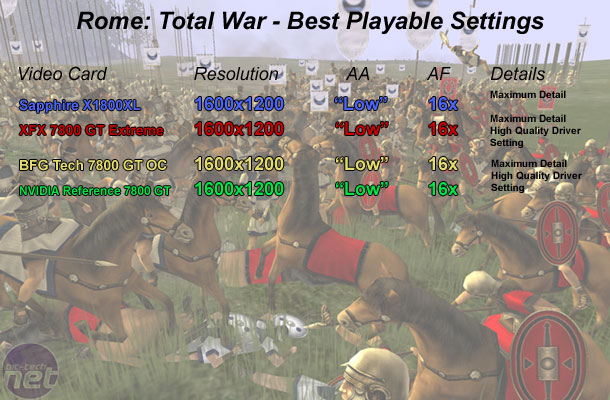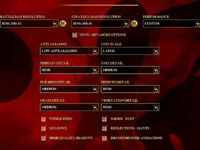Rome: Total War
Publisher: ActivisionIn this comparison, we used the full retail version of Rome: Total War, and we've used part of the tutorial battle to record our manual run through. Our test section incorporates several unit movements along with a lot of units in the scene at the same time - it manages to provide a high level of stress on the video card because of the high polygon and geometry counts.
The driver control panel was used to control Anisotropic Filtering, while we left Anti-Aliasing set to "Application Preference" in order to control AA using the title's in-game graphics settings.
Below is a table of the best-playable settings that we found best for each video card configuration. The title is an RTS, so frame rate isn't quite as critical as it would be in a first person shooter, so we have aimed for 15 frames per second minimum and an average frame rate of 40 frames per second.

With all of the GeForce 7800 GT's we found that there was unacceptable texture shimmering when using the default driver settings. For those who are not sure what texture shimmering is, it is where the closest texture boundaries are under sampled, meaning that the GPU over samples the next texture in the chain resulting in a shimmer at the edges of textures. Shimmering is basically a by-product of the level of detail selection. If the texture filtering algorithm is set to over optimise, you are greeted with texture shimmering.
It looked like the textures that make up the grass were 'swimming' along as you moved forwards behind a unit. We reverted back to Forceware 78.03, and they did not fix the issue when using the quality setting. After this, we reverted back to Forceware 81.84 and tried changing the driver settings from "Quality" to "High Quality" and we found that this fixed most of the problems. All of the very apparent under sampling had disappeared and we saw filtering quality that we've come to expect in this day and age.
Even after setting the driver detail to the high quality setting, we found that the XFX and BFGTech video cards were still the fastest cards in this title, while the reference GeForce 7800 GT was slightly slower than Sapphire's Radeon X1800XL.

MSI MPG Velox 100R Chassis Review
October 14 2021 | 15:04








Want to comment? Please log in.